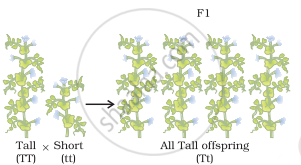Advertisements
Advertisements
प्रश्न
How do Mendel’s experiments show that the traits may be dominant or recessive?
उत्तर
Mendel crossed purebred tall pea plants with purebred dwarf pea plants and found that only tall pea plants were produced in the first generation, and there were no dwarf pea plants. He concluded that the first generation showed the traits of only one of the parent plants tallness. The trait of the other parent plant dwarfness did not show up in the progeny of the first generation.

He then crossed the tall pea plants obtained in the first generation (F1 generation) and found that both tall plants and dwarf plants were obtained in the second generation (F2 generation) in the ratio of 3 : 1. Mendel noted that the dwarf trait of the parent pea plant which disappeared in the first generation progeny reappeared in the second generation. In this way, Mendel’s experiments with tall and dwarf pea plants showed that the traits may be dominant and recessive.

APPEARS IN
संबंधित प्रश्न
How did Mendel interpret his results to show that traits may be dominant or recessive? Describe briefly.
Mendel in one of his experiments with pea plants crossed a variety having round seed with one having wrinkled seeds. Write his observations, giving reasons, of F1 and F2 progeny
What type of plants were used by Mendel for conducting his experiments on inheritance?
The gene for red hair is recessive to the gene for black hair. What will be the hair colour of a person if he inherits a gene for red hair from his mother and a gene for black hair from his father?
Name the scientist who gave the laws of inheritance.
Gregor Mendel's first law of genetics states "Of a pair of contrasted characters, only one can be represented in a gamete by its internal 'factor' State where these factors are found in gametes.
Give the contrasting traits of the following characters in pea plant and mention which is dominant and which is recessive :
Round seed
Why did Mendel choose pea plants for conducting his experiments on inheritance?
State Mendel's second law of inheritance.
The visible characteristic in an organism is known as :
(a) prototype
(b) stereotype
(c) phenotype
(d) genotype
If the ratio of each phenotype of the seeds of pea plants in the F2 generation is 9 : 3 : 3 : 1, it is known as :
(a) tetrahybrid ratio
(b) monohybrid ratio
(c) dihybrid ratio
(d) trihybrid ratio
A man with blood group A marries a woman with blood group O and their daughter has blood group O. Is this information enough to tell you which of the traits-blood group A or O - is dominant? Why or why not?
Only one of the following characteristic of the parents can be inherited by their children. This one is :
(a) deep scar on chin
(b) snub nose
(c) technique of swimming
(d) cut nose
Explain the mechanism of hereditary changes.
Define Heredity. Give two examples.
Answer the following question.
Name the plant Mendel used for his experiment. What type of progeny was obtained by Mendel in F1 and F2 generations when he crossed the tall and short plants? Write the ratio he obtained in F2 generation plants.
Answer the following question.
Why are the traits acquired during the life-time-of-an individual not inherited? Explain.
Two pink coloured flowers on crossing resulted in 1 red, 2 pink and 1 white flower progeny. The nature of the cross will be
If a round, green seeded pea plant (RR yy) is crossed with wrinkled, yellow seeded pea plant, (rr YY) the seeds produced in F1 generation are
If a tall pea plant is crossed with a pure dwarf pea plant then, what percentage of F1 and F2 generation respectively will be tall?
